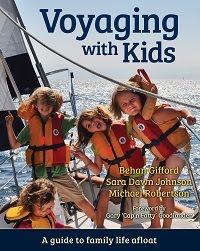Sailing far out to sea, such as on the Mexico-to-Marquesas passage we made this year, it can sometimes seem pointless to keep a careful watch when hour after hour, day after day, you see nothing but 360 degrees of empty ocean. But then, hundreds and hundreds of miles out to sea, in the darkest wee hours, you spot a fast-moving ship on the AIS--still too far over the horizon to be seen. You note that the displayed closest point of approach (CPA) is less than half a mile. You watch, wide awake. The CPA doesn't change and now the lights from your traffic appear as a dim glow on the horizon. You watch a while longer until the displayed time to CPA (TCPA) is just a scant 30 minutes. You make a course change and watch as the CPA increases. You radio the ship to let them know you've changed your heading, to ask if they even see you. You don't get a response. You watch. The green running light on their bow dims as the red light intensifies. Finally, the white stern light comes into view and the drama is passed.
This scenario played out twice aboard Del Viento during our 26-day crossing. It highlights the need for careful watchkeeping, despite a seemingly empty ocean.
From our example, it can seem reasonable to rely on electronics for watchkeeping. AIS alarms and radar alarms can be effectively augment the human eye. They are certainly great watchkeeping companions--and a boon to singlehanders faced with choosing the best times to be fatalistic so they can get some rest. But these electronic devices do not eliminate the need for the human eye. Which means that on most boats, certainly ours, somebody is awake and paying attention 24 hours a day when underway.
How do we manage the sleeping schedule?
Traditionally, crew on long passages will adopt a rigid schedule of 3- or 4-hour watch periods (8 to 6 periods in every 24-hour day). For a double-handed crew (such as parents of a cruising family), this usually means on for 4 hours, off for 4 hours, on for 4 hours, off for 4 hours--for weeks on end. Throw in a third crewmember and this schedule becomes more humane: on for 4 hours, off for 8 hours.
But we rarely have a third crewmember aboard (though Eleanor is only a few years away from being ready…). Instead, we maintain an unorthodox, flexible schedule that works for us and has stood the test of many multi-day passages (we've done it the same way since our pre-kid cruising days).
In short, we employ a watch schedule that takes advantage of our natural sleep patterns and preferences. I am a stay-up-late kind of guy and Windy is a wake-up-early kind of gal. I prefer to be very tired before falling asleep, she merely has to lie down and read a few pages before she is out. So aboard Del Viento, a typical day at sea goes thusly:
1730: At roughly the five-o'clock hour, you'll find all of us awake, topsides or down below, me preparing a meal. When we're done eating, Eleanor and Frances will lead the clean-up. Windy will head to her nav station where she'll fire up the shortwave radio and Pactor modem and try to get weather or emails downloaded. I'll head to the cockpit.
2000: By this time, Windy has said goodnight to all. If one or both of the girls is inclined, they'll join her in bed where she'll read to them for a while before she dozes off. Oftentimes, the girls will then crawl back out of bed and head to the other end of the boat where they'll play or read quietly for a couple hours more.
2200: The girls have maybe fallen asleep by now, or will soon be. On occasion, Eleanor will don a harness and headphones and come sit in the cockpit with me and I'll introduce her to all the excellent music that she missed simply because she was born in the wrong millennium (she rarely makes it past midnight).
0300: I'm tired. Sometimes I'll stay on watch to 0400, sometimes I'll fade by 0200, but 0300 is when I usually hit a wall. I'll go below, wake Windy, brief her on anything she needs to know, and crash into the warm spot she's left in the berth. Windy is a coffee drinker and the last sounds I usually hear come from her getting a cup brewing.
0600: Eleanor is an early riser and will likely be up with the sun and talking to Windy in the cockpit.
0900: This is roughly the time Frances and I stir. We all stay awake for breakfast.
1000: Windy goes down for a nap. The girls and I hang out.
1230: Windy is awake. We all hang out. Watchkeeping is a family affair at this time. We eat.
1400: I go down for a nap.
1700: I wake and begin making dinner. Not only am I the only person aboard not prone to seasickness, I also like to cook.
There, that was 24 hours. The schedule works well for us. Windy and the girls will usually do little school work on passage--sometimes school light, sometimes nothing. But there is lots of downtime for everyone, lots of reading and drawing and writing and music listening.
Of course, that's just how we do it. Lots of other crews handle watchkeeping differently. (All of this information is distilled in Voyaging With Kids: A guide to family life afloat--including thoughts and experiences with taking additional passage crew aboard. Both the print book and eBook are now available. Ask for it at your library, local bookstore, or click the link on this blog.)
--MR
----------
radio email processed by SailMail
for information see:
http://www.sailmail.com

























